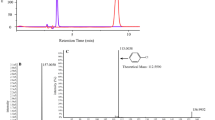Abstract
Three hydroxylated derivatives of PCBs, 2′-hydroxy-4-chlorobiphenyl (2′-OH-4-CB), 3′-hydroxy-4-chlorobiphenyl (3′-OH-4-CB), and 4′-hydroxy-4-chlorobiphenyl (4′-OH-4-CB), were transformed by the PCB degrader, Burkholderia xenovorans. When the bacterium was growing on biphenyl (biphenyl pathway-inducing conditions), all three hydroxylated isomers were transformed. However, only 2′-OH-4-CB was transformed by the bacterium growing on succinate (conditions non-inductive of the biphenyl pathway). Gene expression analyses showed a strong induction of key genes of the biphenyl pathway (bph) when cells were grown on biphenyl, which is consistent with the transformation of the three isomers by biphenyl-grown cells. When cells were grown on succinate, only exposure to 2′-OH-4-CB resulted in expression of biphenyl pathway genes, which suggests that this isomer was capable of inducing the biphenyl pathway. These results provide the first evidence that bacteria are able to metabolize PCB derivatives hydroxylated on the non-chlorinated ring.

Similar content being viewed by others
References
Camara B, Herrera C, Gonzalez M, Couve E, Hofer B, Seeger M (2004) From PCBs to highly toxic metabolites by the biphenyl pathway. Environ Microbiol 6:842–850
Denef VJ, Park J, Tsoi TV, Rouillard JM, Zhang H, Wibbenmeyer JA, Verstraete W, Gulari E, Hashsham SA, Tiedje JM (2004) Biphenyl and benzoate metabolism in a genomic context: outlining genome-wide metabolic networks in Burkholderia xenovorans LB400. Appl Environ Microbiol 70:4961–4970
Field JA, Sierra-Alvarez R (2008) Microbial transformation and degradation of polychlorinated biphenyls. Environ Pollut 155:1–12
Francova K, Mackova M, Macek T, Sylvestre M (2004) Ability of bacterial biphenyl dioxygenases from Burkholderia sp. LB400 and Comamonas testosteroni B-356 to catalyse oxygenation of ortho-hydroxychlorobiphenyls formed from PCBs by plants. Environ Pollut 127:41–48
Gilmartin N, Ryan D, Sherlock O, Dowling D (2003) BphK shows dechlorination activity against 4-chlorobenzoate, an end product of bph-promoted degradation of PCBs. FEMS Microbiol Lett 222:251–255
Kawano M, Hasegawa J, Enomoto T, Onishi H, Nishio Y, Matsuda M, Wakimoto T (2005) Hydroxylated polychlorinated biphenyls (OH-PCBs): recent advances in wildlife contamination study. Environ Sci 12:315–324
Kitamura S, Jinno N, Suzuki T, Sugihara K, Ohta S, Kuroki H, Fujimotoc N (2005) Thyroid hormone-like and estrogenic activity of hydroxylated PCBs in cell culture. Toxicology 208:377–387
Maltseva O, Tsoi T, Quensen J, Fukuda M, Tiedje J (1999) Degradation of anaerobic reductive dechlorination products of Aroclor 1242 by four aerobic bacteria. Biodegradation 10:363–371
Masse R, Lalanne D, Messier F, Sylvestre M (1989) Characterization of new bacterial transformation products of 1,1,1-trichloro-2,2-bis-(4-chlorophenyl)ethane (DDT) by gas-chromatography mass-spectrometry. Biomed Environ Mass Spectrom 18:741–752
Parnell JJ, Park J, Denef V, Tsoi T, Hashsham S, Quensen J, Tiedje JA (2006) Coping with polychlorinated biphenyl (PCB) toxicity: physiological and genome-wide responses of Burkholderia xenovorans LB400 to PCB-mediated stress. Appl Environ Microbiol 72:6607–6614
Pieper DH, Seeger M (2008) Bacterial metabolism of polychlorinated biphenyls. J Mol Microbiol Biotechnol 15:121–138
Rezek J, Macek T, Mackova M, Triska J (2007) Plant metabolites of polychlorinated biphenyls in hairy root culture of black nightshade Solanum nigrum SNC-9O. Chemosphere 69:1221–1227
Safe S, Hutzinger O, Jones D (1975) Mechanism of chlorobiphenyl metabolism. J Agric Food Chem 23:851–853
Sondossi M, Barriault D, Sylvestre M (2004) Metabolism of 2,2′- and 3,3′-dihydroxybiphenyl by the diphenyl catabolic pathway of Comamonas testosteroni B-356. Appl Environ Microbiol 70:174–181
Ueno D, Darling C, Alaee M, Campbell L, Pacepavicius G, Teixeira C, Muir D (2007) Detection of hydroxylated polychlorinated biphenyls (OH-PCBs) in the abiotic environment: surface water and precipitation from Ontario, Canada. Environ Sci Technol 41:1841–1848
Acknowledgments
This work was supported by the National Institute of Health (NIH), Award Number 2P42 ES013661-05. We thank Hans-Joachim Lehmler (University of Iowa) for providing the hydroxylated PCB congeners used in this study.
Author information
Authors and Affiliations
Corresponding author
Electronic supplementary material
Below is the link to the electronic supplementary material.
Rights and permissions
About this article
Cite this article
Tehrani, R., Lyv, M.M., Kaveh, R. et al. Biodegradation of mono-hydroxylated PCBs by Burkholderia xenovorans . Biotechnol Lett 34, 2247–2252 (2012). https://doi.org/10.1007/s10529-012-1037-x
Received:
Accepted:
Published:
Issue Date:
DOI: https://doi.org/10.1007/s10529-012-1037-x




